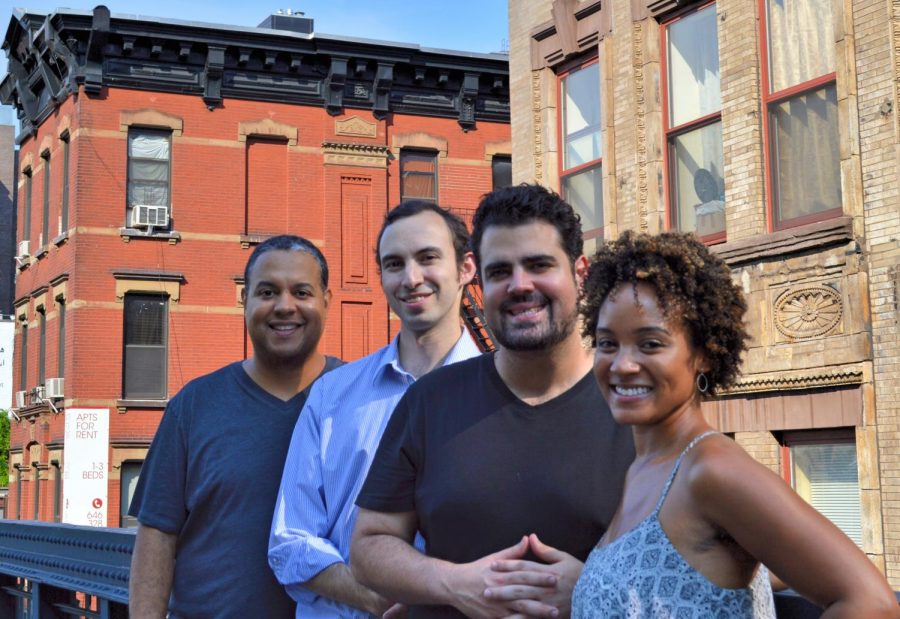The Harlem Quartet impresses at Jewel Box
October 29, 2019
Northeastern Illinois University continued its 20th anniversary celebration of its annual “Jewel Box” series by welcoming New York-based Harlem Quartet. The Harlem Quartet, comprised of violinists Ilmar Gavilan and Melissa White, violist Jaime Amador and cellist Felix Umansky, captivated the audience with their classically concentrated set, playing numbers composed by William Bolcom, Fanny Mendelssohn, Guido Lopez Gavilan and Johannes Brahms.
The performance began with “Three Rags for String Quartet” by Bolcom. The quartet transitioned from “Poltergeist” to “Graceful Ghost” before finally finishing with “Incineratog.” Bolcom’s trio of numbers was a nice choice to whet the audience’s appetite. The number embraced a skeptical crowd and forced us to engage our senses. It also stimulated the mind with the introduction of competing notes. This set was lighthearted yet meticulous, offering a sense of expertise and precision over a nonchalant sound.
However, the performance really found its footing when the Harlem Quartet commenced Fanny Mendelssohn’s “String Quartet in E-Flat,” made up of “Adagio ma non troppo,” “Allegretto,” “Romanize” and “Allegro molto vivace”. Audience members may have been familiar with Mendelssohn’s brother Felix, who was most famous for “An Overture to a Midsummer Night’s Dream.” However, on this night, the compositional genius of Fanny Mendelssohn deservedly took center stage.
The Harlem Quartet introduced the piece by sharing the harrowing, tragic tale of Mendelsson, whose art was spurned based on the perceived inferiority of her sex. The piece, recovered in 1970, was initially discarded, a piece composed before its time relative to societal standards. However, the number has since experienced a revival that has offered it the appreciation it was wrongfully deprived of at the time of conception. Fittingly, the piece staggered between somber and uplifting chords, forcing one to ponder whether the piece mirrored the peaks and valleys of Mendelsson’s life. A sense of melancholy permeated throughout the auditorium before being displaced by a humbling sense of urgency.
As the audience listened to the band transition between pieces, the quartet’s musical prowess became more and more apparent. Their fingers manipulated and navigated the strings with a familiar precision that subconsciously forced audience members to inch forward in their seats, almost imperceptibly. Such unpredictability was both intoxicating and a welcome introduction coming out of the intermission.
The next piece was written by Gavilan’s father, Guido. “Cuarteto En Guaguancó,” which Gavilan explained was meant to be accompanied by drums, operated as a complete deviation away from the rest of the set. The number offered a very pointed beat before transitioning into a melody that followed a classical epic format. As one performer’s fingers searched the strings, the others would complement the notes with gentle knocks on the wooden bases of their instruments. Overall, “Cuarteto En Guaguanco” was an excellent addition to the performance.
After a final intermission, the band resumed with a performance of Johannes Brahms’s “Vivace,” a number that transitioned between uniformity and dueling instruments. For this writer, “Vivace” seemed relatively nondescript, particularly in comparison with the piece composed by Gavilan. Nevertheless, its placement reinvigorated a fatigued crowd for the impending grand finale.
“Andante” followed “Vivace” and dripped with valor, as though it were composed to serve as a champion’s anthem. Resounding crescendos were complemented by contemplative intermissions. One second, the piece had the audience racing towards victory, while the next we were forced to appreciate the journey that brought us there. Even the performers themselves became lost in the progressions as their contorted facial expressions were indicative of a successful exhibition.
The performers picked up the pace during “Agitato (Allegretto non troppo),” putting their full musical abilities on display. Amador and Galvanic truly shone here, briefly abandoning the team effort that defined the majority of the set to provide an energy that had been previously absent.
Finally, “Poco Allegretto con Variazioni” was a modernized version of regality, seemingly one beat quicker than the classical orchestras of yesteryear. Quite frankly, the number would seamlessly blend in at a formal ceremony, though it admittedly illustrated a story too complex to be relegated to the background of any event. The piece demanded center stage and received the adoration is deserved.
To conclude the performance, the Harlem Quartet performed “A-Train” as an encore. Gavilan reminisced that “A-Train” was the first number they added to their repertoire. The quartet’s enthusiasm was palpable, as they tapped their feet in a rhythmic manner while flashing bright smiles at one another, amusing their counterparts with improvisations that almost went undetected by the audience. Each member of the Harlem Quartet had their moment in the spotlight and were shown the appreciation from audience members at the wine and cheese gathering afterward, embracing their adorers and basking in the spotlight.








